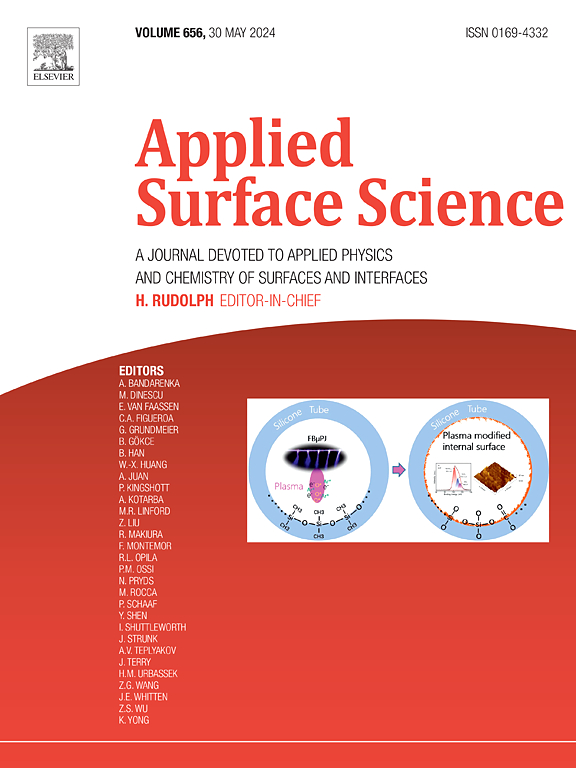石墨烯掺杂聚苯胺薄膜的电化学沉积增强锌的耐蚀性
IF 6.3
2区 材料科学
Q2 CHEMISTRY, PHYSICAL
引用次数: 0
摘要
纯聚苯胺(PANI)、掺杂石墨烯的 PANI(PANI-GR)和掺杂石墨烯纳米颗粒的 PANI(PANI-GRNPs)涂层是从水杨酸钠和苯胺的水溶液中电沉积到锌基板上的。石墨烯是在酸性介质中通过电化学剥离石墨获得的。在加入复合材料之前,这两种形式的石墨烯都分散在表面活性剂 SDS 中。在 1 M NaCl 介质中对裸基底和涂层基底的电化学行为进行了评估。研究表明,通过电静电模式进行电沉积是在锌基底上涂覆聚苯胺(PANI)和 PANI-石墨烯复合材料的有效方法。利用 X 射线衍射 (XRD) 和拉曼光谱进行的结构分析证实了石墨烯与 PANI 基体的成功结合。石墨烯的加入大大改善了涂层质量,提高了表面均匀性,并最大限度地减少了表面裂纹的形成。机械测试表明,与纯 PANI 和 PANI-GRNPs 涂层相比,PANI-GR 复合涂层具有更高的显微硬度。PANI-GR 涂层的耐腐蚀性优于裸锌和纯 PANI 涂层。这种增强的耐腐蚀性能归因于石墨烯改进的阻隔性能、更惰性的腐蚀电位、减少的阳极和阴极分支以及增强的电荷转移机制。本文章由计算机程序翻译,如有差异,请以英文原文为准。


Electrochemical deposition of graphene-doped polyaniline films for enhanced zinc corrosion resistance
Pure polyaniline (PANI), graphene-doped PANI (PANI-GR), and graphene nanoplatelet-doped PANI (PANI-GRNPs) coatings were electrodeposited galvanostatically from an aqueous solution of sodium salicylate and aniline onto zinc substrates. Graphene was obtained via the electrochemical exfoliation of graphite in an acidic medium. Prior to incorporation into the composites, both forms of graphene were dispersed in the surfactant SDS. The electrochemical behaviour of the bare and coated substrates was evaluated in 1 M NaCl. The study demonstrates that electrodeposition via galvanostatic mode is an effective method for coating zinc substrates with polyaniline (PANI) and PANI-graphene composites. Structural analyses using X-ray diffraction (XRD) and Raman spectroscopy confirmed the successful integration of graphene into the PANI matrix. The incorporation of graphene significantly improved the coating quality, enhancing surface homogeneity and minimizing the formation of surface cracks. Mechanical testing revealed that PANI-GR composite coatings exhibited superior microhardness compared to pure PANI and PANI-GRNPs coatings. The PANI-GR coatings outperformed the corrosion resistance of both bare zinc and pure PANI coatings. This enhanced corrosion resistance is attributed to the improved barrier properties, more noble corrosion potential, decreased anodic and cathodic branches and enhanced charge transfer mechanisms facilitated by graphene incorporation.
求助全文
通过发布文献求助,成功后即可免费获取论文全文。
去求助
来源期刊

Applied Surface Science
工程技术-材料科学:膜
CiteScore
12.50
自引率
7.50%
发文量
3393
审稿时长
67 days
期刊介绍:
Applied Surface Science covers topics contributing to a better understanding of surfaces, interfaces, nanostructures and their applications. The journal is concerned with scientific research on the atomic and molecular level of material properties determined with specific surface analytical techniques and/or computational methods, as well as the processing of such structures.
 求助内容:
求助内容: 应助结果提醒方式:
应助结果提醒方式:


